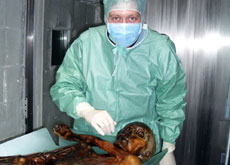Swiss help solve iceman death mystery

The cause of death of "Ötzi" - the prehistoric man frozen in a glacier for more than 5,000 years - has finally been proven, say a Swiss-Italian team of researchers.
The scientists, including Frank Rühli from Zurich University, used modern X-ray based technology to show that Ötzi died from a lesion to an artery near the shoulder, caused by an arrowhead.
Ötzi’s mummified body was found in the melting ice of the Schnalstal glacier in the Italian Alps in 1991.
He has since undergone many scientific tests to find out why he died and more about his lifestyle. This latest finding, made using multislice computer tomography (CT), was published by Zurich University on Wednesday.
“We have now found, in close collaboration with researchers from Italy, that he was actually hit by an arrowhead which penetrated his shoulder blade and ended up below the clavicle,” Rühli told swissinfo.
“The arrowhead actually hit an artery and we see the lesion of the artery. We also see in these CT images a large haematoma, which means he must have had huge bleeding into the thorax cavity.” Ötzi died of blood loss, he added.
Rühli said the death was probably quick. Archaeologists have yet to determine what caused the injury, but theories include a fight or hunting accident.
Sophisticated scanning technique
The cause of death was determined using a very sophisticated scanning technique, which is also used in modern medicine.
“We applied a state-of-the-art CT machine, which is similar to an x-ray machine, which has a beam which penetrates the body and rotates around the patient so you have a cross-section image. Once you stack these images up you have 3-D information,” explained Rühli.
There was therefore no need to carry out an autopsy on the body.
The results of the research have been published online in the Journal of Archaeological Science and will be covered in the German and United States issues of the National Geographic magazine in July.
Further study is planned on the circumstances of Ötzi’s death and the mummy’s rate of decomposition.
Swiss Mummy Project
Rühli, from the university’s Institute of Anatomy, is a co-chair of the Swiss Mummy Project, which has been running for ten years at the institution.
He acted as a scientific consultant for determining the cause of death of the Egyptian pharaoh Tutankhamen in 2005. It was here that he met the team investigating the iceman’s death.
Rühli said there were several reasons why the Copper Age Italian mummy continued to fascinate.
“It’s still quite amazing to have a body of this age in such good condition, they are extremely rare, and the fact he died suddenly is like a snap shot of daily life 5,000 years ago,” he said, adding that much could be learned from his bags and clothes which were daily attire and not ceremonial.
“The whole story of whether he was killed or it was an accident, that contributes as well,” he told swissinfo.
swissinfo, Isobel Leybold-Johnson
Frank Rühli from Zurich University’s Institute of Anatomy, carried out the research in association with colleagues from the South Tyrol Museum of Archaeology in Bolzano and the General Hospital in Bolzano.
The medical and anatomical expert has specialist knowledge of ancient mummies and is co-chair of the Swiss Mummy Project at the university.
The aim of this project is to use, whenever possible, non-invasive methods to gain information on the life, death and after-death alterations, such as embalming-related changes, on ancient mummies.

In compliance with the JTI standards
More: SWI swissinfo.ch certified by the Journalism Trust Initiative










You can find an overview of ongoing debates with our journalists here . Please join us!
If you want to start a conversation about a topic raised in this article or want to report factual errors, email us at english@swissinfo.ch.